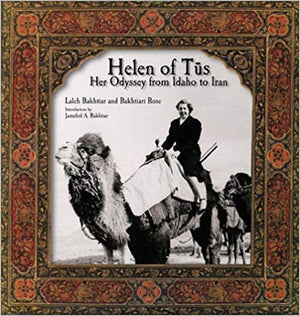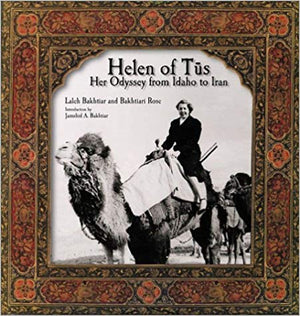



About
This is not a typical book and one should not expect to read it as such. First, the style of the book is very different than what we typically read in English, and it is only after you begin, that it's faint familiarity begins to awaken in you. Told in the naqqali (Storyteller) style, this book is structured similarly to our rich tradition of storytelling depicted in such books as the Shahnameh (Book of Kings, Ferdowsi). Second, the book is full of photos, each captioned, so you can begin to somewhat digest the book that way. Third, is to read the excerpts from the more than 300 letters, written in Helen's wonderfully American style, as a whole other way to enjoy the book. And finally there are the explained perspectives that puts everything into context and fills in the family's viewpoint as described by Helen's equally talented and inspired daughters.
It is the story of Helen Jeffreys, an American from Idaho, who came to Iran as a nurse in the thirties. Who came to raise a family, but also came to serve and love Iran beyond anything we can imagine today. The book is an assemblage, a transcript, a story taken from the letters that Helen wrote to her children during her incredible life. The family's photos and mementoes were used to bring the words to life by 2 of her daughters and Rose (Shireen). and Mary Nell (Laleh). In 1927 Helen met and married an Iranian, a dapper Abol Bakhtiar who had come to America to seek his fortune. The Wild Wild West meets the Wild Wild East.
Helen Jeffreys originally came from Idaho, of strong Scottish, Irish and English stock. Helen's family, like many steadfast American families of the time, were hardy, tried and true blue Americans, who originally came to the lands of the Nez Pierce Native Americans in Idaho, traveling along the famous Oregon Trail as pioneers. They fought in the Civil, Spanish-American, and First World wars. After World War II, Truman proposed what became known as the great "4-Point Plan", one of which intended for America to help spread technology and among other things public health know-how all over the world. A precursor to Kennedy's Peace-Corps. With her family strength fully instilled, Helen joined the Navy as a nurse under the 4-point program and took her commission to Iran with Abol. She then traveled throughout Iran's southwestern provinces bringing public health care to the famine stricken villages of Iran.
Abol came from the famous Bakhtiari tribe in southwestern Iran. The Bakhtiari were famous horsemen and considered to be the bravest fighters, staunchly opposed to any unfair rule by force, remnants of the long forgotten Persian warriors.
Imagine the courage it must have taken for Abol to make his way alone, halfway across the globe to America. Abol, although not featured in the title of the book, was no less than a truly marvelous Iranian. He worked his way from nothing to becoming an American educated physician returning to Iran to become a doctor. He climbed (literally, he once went on an expedition to climb Mt. Damavand and made it to the top 4 hours before anyone else on the team!) and worked his way to the top. The sheer determination of this man, un-dampened by anything, disallowing any doubt to creep into his path, is awe-inspiring. He is in some ways the very essence of the American Dream.
It is also a book of firsts; The first known American to marry an Iranian in the America and go to Iran. The first American Nurse to come to Iran. The first All American Iranian football hero (Helen and Abol's eldest son Jamshid). And there are many more in the book. Helen of Tus is not about the past, it's about potential. What keeps coming back to you is what a perfect example this is of how naturally cultures can in fact blend. That by interacting one can not only respect and understand another's culture, but serve to strengthen their own.
This is not a typical book and one should not expect to read it as such. First, the style of the book is very different than what we typically read in English, and it is only after you begin, that it's faint familiarity begins to awaken in you. Told in the naqqali (Storyteller) style, this book is structured similarly to our rich tradition of storytelling depicted in such books as the Shahnameh (Book of Kings, Ferdowsi). Second, the book is full of photos, each captioned, so you can begin to somewhat digest the book that way. Third, is to read the excerpts from the more than 300 letters, written in Helen's wonderfully American style, as a whole other way to enjoy the book. And finally there are the explained perspectives that puts everything into context and fills in the family's viewpoint as described by Helen's equally talented and inspired daughters.
It is the story of Helen Jeffreys, an American from Idaho, who came to Iran as a nurse in the thirties. Who came to raise a family, but also came to serve and love Iran beyond anything we can imagine today. The book is an assemblage, a transcript, a story taken from the letters that Helen wrote to her children during her incredible life. The family's photos and mementoes were used to bring the words to life by 2 of her daughters and Rose (Shireen). and Mary Nell (Laleh). In 1927 Helen met and married an Iranian, a dapper Abol Bakhtiar who had come to America to seek his fortune. The Wild Wild West meets the Wild Wild East.
Helen Jeffreys originally came from Idaho, of strong Scottish, Irish and English stock. Helen's family, like many steadfast American families of the time, were hardy, tried and true blue Americans, who originally came to the lands of the Nez Pierce Native Americans in Idaho, traveling along the famous Oregon Trail as pioneers. They fought in the Civil, Spanish-American, and First World wars. After World War II, Truman proposed what became known as the great "4-Point Plan", one of which intended for America to help spread technology and among other things public health know-how all over the world. A precursor to Kennedy's Peace-Corps. With her family strength fully instilled, Helen joined the Navy as a nurse under the 4-point program and took her commission to Iran with Abol. She then traveled throughout Iran's southwestern provinces bringing public health care to the famine stricken villages of Iran.
Abol came from the famous Bakhtiari tribe in southwestern Iran. The Bakhtiari were famous horsemen and considered to be the bravest fighters, staunchly opposed to any unfair rule by force, remnants of the long forgotten Persian warriors.
Imagine the courage it must have taken for Abol to make his way alone, halfway across the globe to America. Abol, although not featured in the title of the book, was no less than a truly marvelous Iranian. He worked his way from nothing to becoming an American educated physician returning to Iran to become a doctor. He climbed (literally, he once went on an expedition to climb Mt. Damavand and made it to the top 4 hours before anyone else on the team!) and worked his way to the top. The sheer determination of this man, un-dampened by anything, disallowing any doubt to creep into his path, is awe-inspiring. He is in some ways the very essence of the American Dream.
It is also a book of firsts; The first known American to marry an Iranian in the America and go to Iran. The first American Nurse to come to Iran. The first All American Iranian football hero (Helen and Abol's eldest son Jamshid). And there are many more in the book. Helen of Tus is not about the past, it's about potential. What keeps coming back to you is what a perfect example this is of how naturally cultures can in fact blend. That by interacting one can not only respect and understand another's culture, but serve to strengthen their own.
Helen of Tus: Her Odyssey from Idaho to Iran
- Regular price
- $29.95
- Sale price
- $29.95
- Regular price
-
Couldn't load pickup availability






